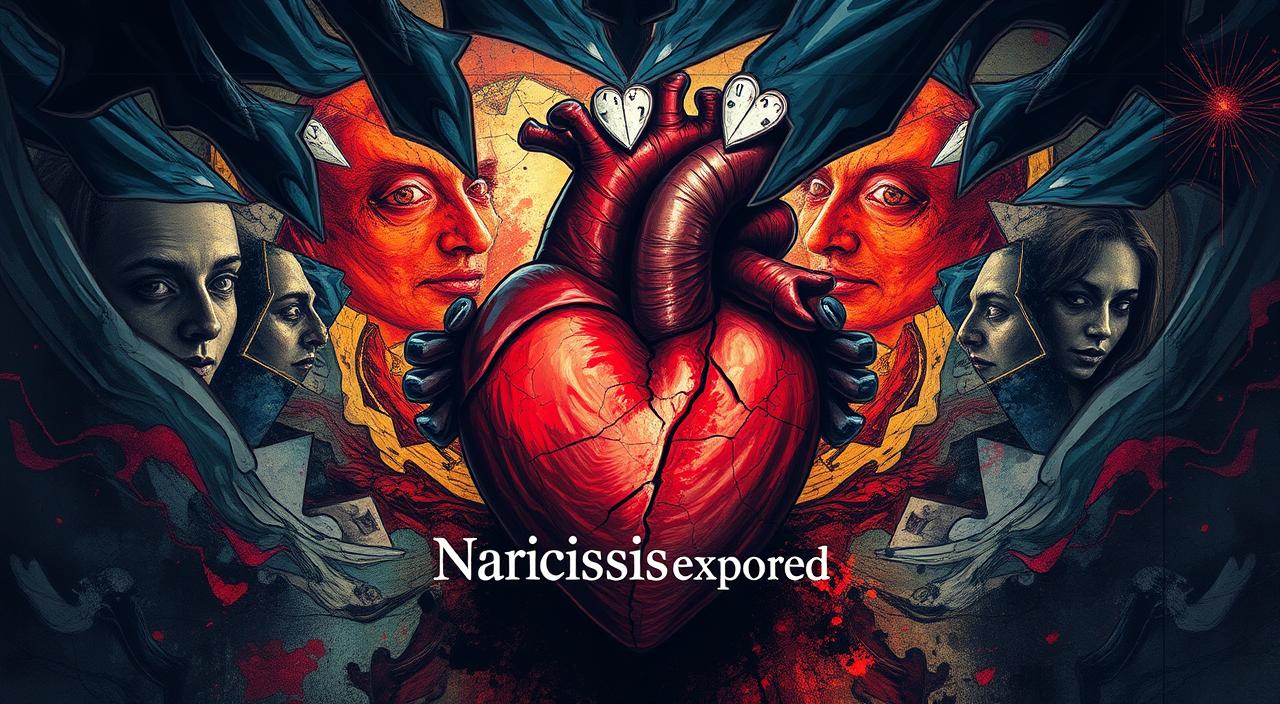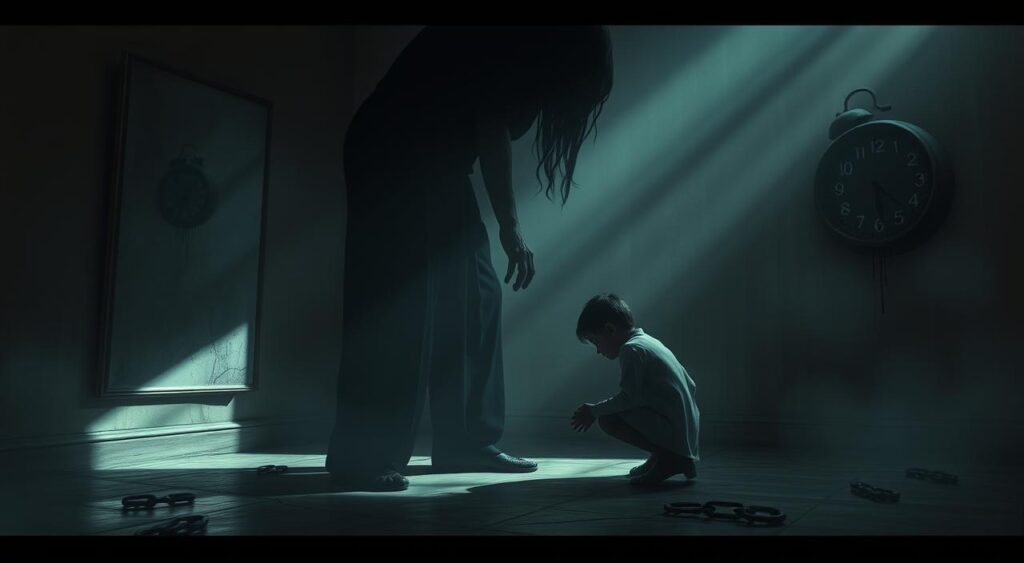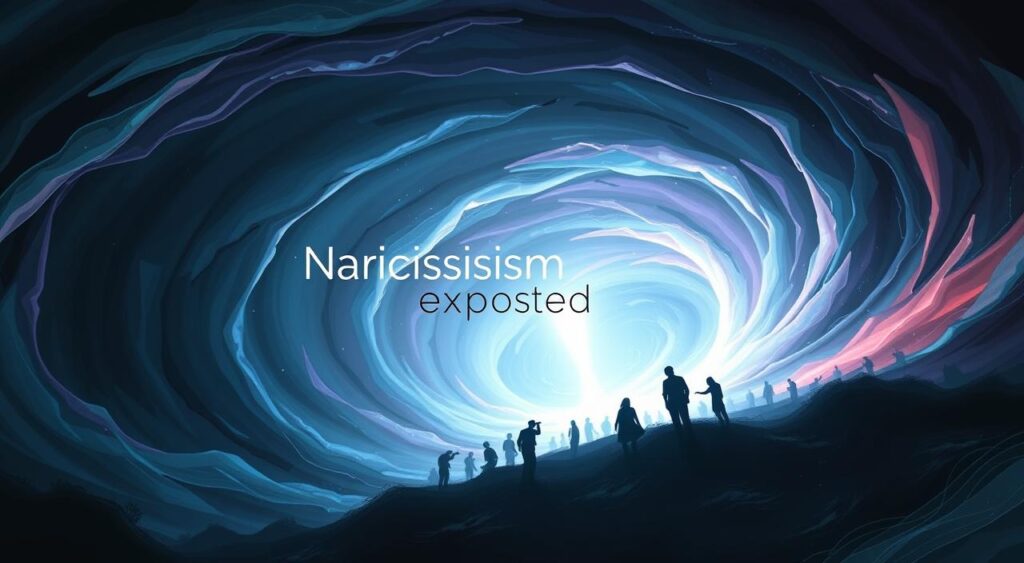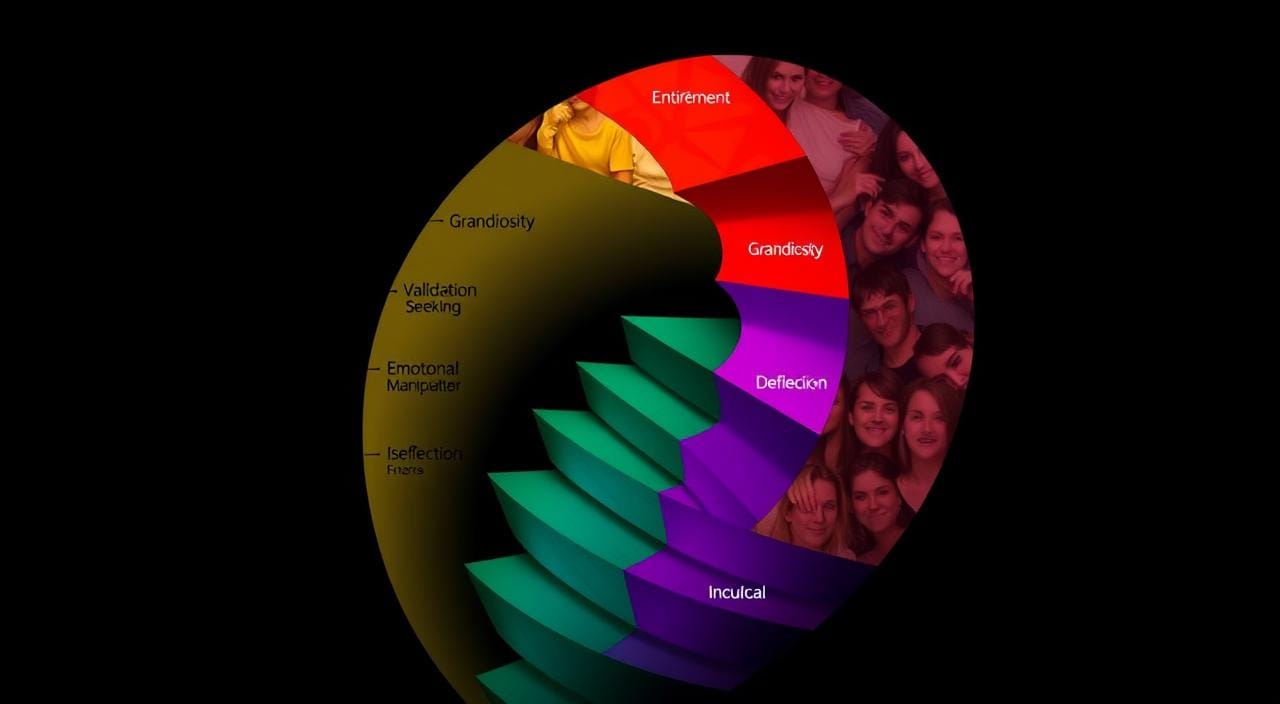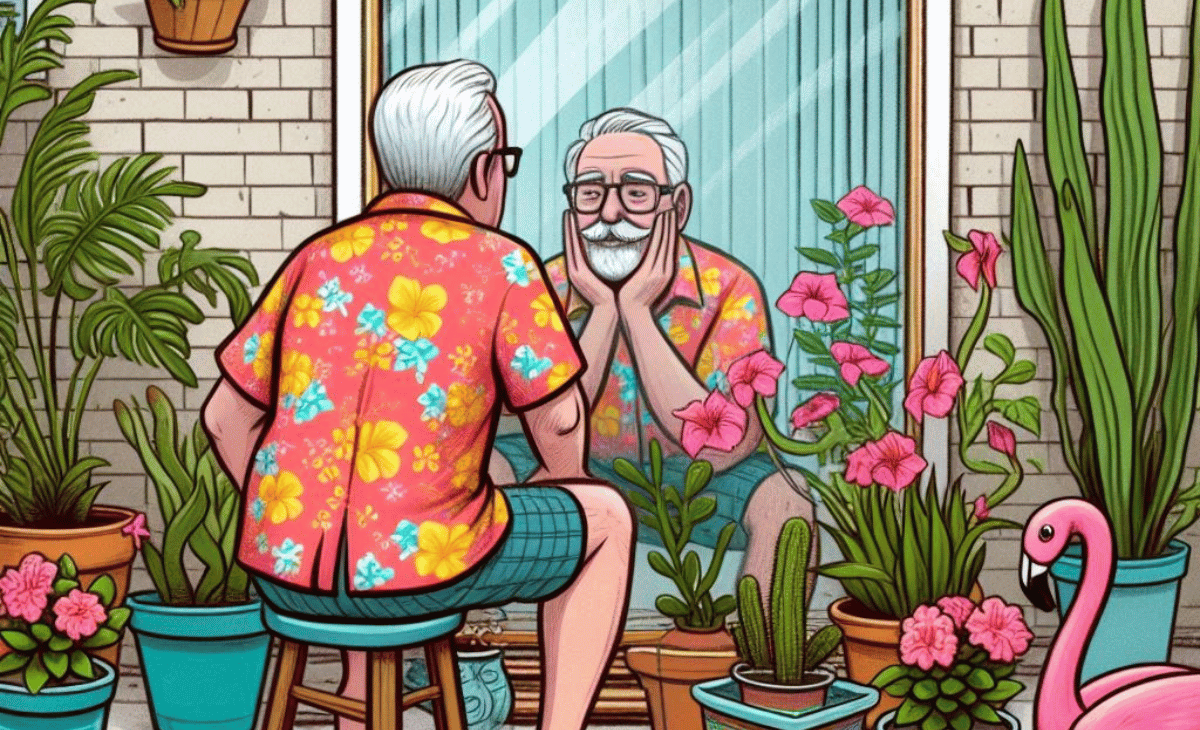Emotional abuse leaves deep scars, making victims feel powerless and trapped. I’ve been there, and I know how hard it is to get back your sense of self. Emotional abuse slowly takes away a person’s confidence and freedom. It’s hard to break free.
But, there’s hope that even the most deep-rooted emotional abuse can change1. Experts believe abusive partners can change, but they often make false promises to keep victims trapped1. Changing isn’t easy, as1 there’s no quick fix. The abuser must truly want to change on their own. So let’s learn can an emotionally abusive person change?Stages of Trauma Bonding: Recognizing the CycleBreaking Free: Trauma Bond Withdrawal Symptoms
Key Takeaways
- Emotional abuse is a form of manipulation that slowly erodes a person’s confidence and autonomy.
- While it is possible for emotionally abusive individuals to change, the process is challenging and requires a genuine commitment from the abuser.
- Abusive behavior is often learned over time and can stem from past trauma or unhealthy role models.
- Effective change involves stopping self-centering, developing empathy, acknowledging harm, and participating in accountability processes.
- Unlearning abusive patterns requires time, intervention programs, and addressing underlying issues like depression or alcoholism.
Understanding Emotional Abuse
Emotional abuse often works quietly, slowly taking away a person’s self-worth. It’s not always clear, as the abuser uses tricks like making you doubt your own thoughts and feelings2. These tricks can make you feel trapped, alone, and unsure if you’re being abused2.
The Insidious Nature of Emotional Abuse
Emotional abuse can be many things, like putting you down or controlling what you do2. The goal is to chip away at your confidence and control how you act2. This often means constantly criticizing or making you doubt yourself, leaving you feeling mixed up and scared2.
The Impact of Emotional Abuse on Victims
Being emotionally abused can really hurt, causing deep emotional pain and losing your sense of self2. You might feel sad, worried, or have PTSD, among other mental health problems2. Getting back your confidence and trust is hard, but you can do it with help from experts and friends2.
| Impact of Emotional Abuse | Symptoms |
|---|---|
| Psychological Trauma |
|
| Loss of Self-Esteem |
|
| Emotional Disintegration |
|
“Emotional abuse can take many forms, all working to disintegrate the victim’s emotional state.”
My Personal Journey as an Emotional Abuser
I used to be an emotional abuser, and it’s not something I’m proud of3. I would charm my partner’s friends and family but hurt them at home. To outsiders, I seemed perfect, but in private, I was a different story. Now, it’s clear why my partner’s friends didn’t see my true self, only my good qualities.
Emotional abuse can be as bad as physical abuse, with studies showing it can cause PTSD, suicidal thoughts, and more in victims3. People who’ve been emotionally abused often feel the same pain as those who’ve faced physical or sexual abuse3.
Looking back, I see how important it was to change. It was hard, but I worked hard, reflected on my actions, and wanted to be better. With therapy and a real wish to change, I broke the cycle of abuse and became a better partner3. Therapy is key in healing, but finding the right therapist can take time and money is a big concern3. Sometimes, antidepressants help, and many insurance plans cover them3.
Self-care like therapy, meditation, exercise, and setting boundaries is key to healing from emotional abuse.3 Victims may feel many emotions towards their abusers, like love or anger, which are normal and need time to work through.3 The idea that victims are to blame is wrong, but it’s common. Remember, the blame is always on the abuser, not the victim3.
My journey was tough, but I’m glad I can reflect on it and work on being better3. Sharing my story might help others who struggle with similar issues to seek help and change for the better3.
Recognizing the Signs of Emotional Abuse
Spotting emotional abuse can be tricky because the person doing it uses sneaky ways to control and manipulate the victim4. But, by paying attention to certain actions and how the victim acts, we can start to see how harmful emotional abuse is.
Clues to Identify Emotional Abuse
One early sign someone might be in an abusive relationship is if they talk about their partner’s reactions or feel guilty a lot4. If a person always checks their actions or needs constant approval, it might show they’re in a bad situation4.
Emotional abuse can show up in many ways, like being called mean names, being made fun of in public, or having their feelings ignored4. Abusers might also track their partner, spy on them online, lie to them, or make all the choices4.
Another clue is when someone loses their freedom, their own identity, and feels less like themselves5. They might pull away, feel bad about themselves, or seem scared and dependent5.
To spot emotional abuse, we need to be sharp and understand how abusers manipulate and control4. By learning more and paying attention to those around us, we can start to tackle this big problem5.
“Emotional abuse can be so subtle that the victim may not even realize what’s happening, making it even harder to identify and address.”
The Cycle of Blame and Self-Doubt
In the emotional abuse cycle, the victim feels more to blame over time6. As weeks and months go by, they doubt their choices and live in fear. They start to question how to be good enough6. They lose faith in their instincts and depend more on their abuser, losing who they are6. They seek approval, wanting to be seen as good by their partner, but they’re made to think they’re the issue6.
This blame and doubt cycle is a key sign of emotional abuse7. Abusers use jealousy, manipulation, and gaslighting to control and hurt their victims. Their actions often come from their own fears and a need for power7. This can lead to a big loss of self-worth and freedom, causing mental health problems like depression and anxiety7.
Those who face long-term emotional abuse may show low confidence and trouble managing their feelings. They might act aggressively or passively, or even harm themselves7. This kind of violence can deeply affect their mental health. It’s important to see and stop the blame and doubt cycle to escape emotional abuse7.
| Emotional Abuse Tactics | Impact on Victims |
|---|---|
|
|
“Emotional abuse can be just as damaging as physical abuse, leaving victims feeling worthless, hopeless, and trapped in a cycle of self-doubt and blame.”
The Four Pillars of Abuse
To understand emotional abuse, we must look into the abuser’s psychology and mindset. The M3ND Project’s article explains the four key pillars of abuse. These are Faulty Belief Systems, Image Management, Entitlement, and Preferential Treatment.
Faulty Belief Systems
An abuser often has a flawed belief system. This can come from deep-seated patriarchy, misogynistic views, cultural biases, or distorted religious beliefs that put women down8. These beliefs make the abuser feel superior and justify their abuse. It’s hard for them to see the harm they cause9.
Image Management
Abusers work hard to look good in public, hiding their true nature. This makes it hard for others to see their real selves. They avoid blame and keep abusing8. They care more about their image than their victims’ well-being9.
| Pillar | Description |
|---|---|
| Faulty Belief Systems | Beliefs that make the abuser feel superior and entitled, often based on patriarchy, misogyny, and cultural biases. |
| Image Management | Abusers try to keep a good image to hide their bad behavior and avoid blame. |
“Understanding the four pillars of abuse is crucial for recognizing abusive patterns, preventing further harm, and holding abusers accountable for their actions.”
Knowing these pillars helps us spot and tackle emotional abuse. It’s key to stopping the cycle of harm and helping victims heal and recover89.
can an emotionally abusive person change
Can emotionally abusive people change? This is a tough question with different views. Some experts think abusers can change with the right help. But, it’s rare for them to really change because changing deeply is hard work10.
Emotional abuse comes from many things like bad communication and negative views on relationships. Therapy can help abusers see their wrong ways and learn better ways to be with others10.
But, if the abuser doesn’t want to change, it’s harder. People who are verbally abusive often struggle with anger and insecurity. Programs and counseling that improve communication and empathy can help them change10.
Changing an abuser is complex and takes a lot of effort. It needs the abuser’s commitment, help from experts, and a strong support system. Changing is hard but possible for those who are willing to work at it10.
| Statistic | Source |
|---|---|
| Approximately 1 in 4 women and 1 in 9 men experience severe intimate partner physical violence, intimate partner contact sexual violence, or intimate partner stalking with impacts such as injury, fearfulness, post-traumatic stress disorder, use of victim services, contraction of sexually transmitted diseases, etc. | 11 |
| Nearly half of all women and men in the United States have experienced psychological aggression by an intimate partner in their lifetime. | 11 |
| Children who witness domestic violence are more likely to exhibit behavioral problems, struggle academically, and are at a higher risk of perpetuating the cycle of abuse in their own relationships. | 11 |
| Only about 34% of people who are injured by intimate partners receive medical care for their injuries. | 11 |
| Individuals who have experienced childhood trauma, such as abandonment or neglect, are more likely to exhibit abusive behaviors in their adult relationships. | 11 |
| On average, nearly 20 people per minute are physically abused by an intimate partner in the United States. | 11 |
“Overcoming abusiveness can be a decades-long process for some individuals.”12
Changing an abuser is tough but possible. With a strong will to grow, professional help, and support, some can change and have better relationships10. But, changing takes a lot of work and time from the abuser.
The Challenges of Change for Abusers
Changing an abuser is hard and complex. Detecting real change in an abuser is tough. Many abusers make empty promises to their victims13. They promise to change and even go to therapy, but it’s often a way to control, not truly change13.
Entitlement and Emotional Intelligence
Abusers often feel they deserve special treatment, which makes changing hard13. This belief is hard to challenge13. They also struggle with low emotional intelligence, showing in impulsive and defensive behavior13. This makes real change less likely.
Emotional abuse leaves deep scars14. Victims feel isolated, doubtful, ashamed, and powerless14. Healing takes commitment, consistency, and support from both sides15.
| Indicators of Change | Indicators of No Change |
|---|---|
|
|
Changing abusers faces big hurdles, like feeling entitled and lacking emotional smarts13. Facing and tackling these issues is key to real change15.
Intervention Programs and Counseling
Dealing with emotional abuse is more than just punishing the person who did it. Studies show that when abusers join emotional abuse intervention programs, they’re less likely to hurt again16. These programs aim to fix the deep reasons behind abusive behavior, like low emotional smarts, feeling entitled, and old-fashioned gender beliefs16.
Changing an abuser’s ways is hard and can take a year or two to see real change16. They need to stick with good therapy, join support groups, and read books suggested by their therapist or wanted by the victim16. The key is for the abuser to work with therapists and change their bad habits and beliefs.
| Approach | Effectiveness |
|---|---|
| Cognitive Behavioral Therapy | Small but significant reductions in abuse17 |
| Duluth Model | Small but significant reductions in abuse, similar effects to arrest and prosecution without treatment17 |
| Intensive Day-long “Orientation” Session | More successful in motivating abusers to stay in treatment17 |
The model of behavior change explains how an abuser might think about changing: from not thinking about it to being ready for change, then taking action, and finally keeping up with the new habits17. Having the right kind of counseling for abusers and therapeutic approaches for change is key to ending emotional abuse.
By tackling the deep reasons behind emotional abuse and giving abusers the tools and support to change, these emotional abuse intervention programs help lead to better, more respectful relationships1617.
The Role of Support Systems
Getting out of an emotionally abusive relationship needs a strong support system. Emotional abuse can ruin relationships and cause lasting emotional damage18. This makes healing hard but worth it18. Not recognizing abuse early can lead to losing friends and making it harder to find support18. So, having people to count on is key.
Preferential Treatment and Group Think
Abusers often make it seem like they’re not abusive. This makes it hard to see the abuse19. When others support the abuser, they help keep the abuse going. They might not hold the abuser accountable or believe the victim18. This kind of thinking, called group think, makes it harder to stop the abuse18.
Knowing what someone in emotional abuse needs is powerful19. But, supporters can get tired and lose empathy19. It’s important for those helping to take care of themselves too.
| Importance of Support Systems | Impact of Preferential Treatment |
|---|---|
|
“Knowledge is power; finding out what support someone experiencing emotional abuse might need or want can be empowering.”19
A strong support system is crucial for escaping and healing from emotional abuse. By understanding how abusers act and how to support victims, we can help them break free and take back their lives181912.
Breaking the Cycle of Abuse
Getting over emotional abuse and healing from bad relationships is hard but doable for those ready to work hard20. The first step is for the abuser to face their wrong beliefs and ways of acting20. This change can take about one to two years, needing therapy, group support, and reading to fix their bad habits20.
After the abuser starts to change, it’s key to keep the victim’s friends close and not let the abuser get special treatment20. Healing means the abuser owns up to their wrongs and the victim’s friends offer strong support21.
The cycle of abuse has four stages: tension, incident, making up, and calm21. Abuse can change over time or stop and then start again21. Getting help from friends, therapists, building confidence, and getting outside help are key steps to stop the cycle21.
The cycle of abuse theory has faced criticism for not being diverse enough, mainly focusing on white, cisgender, straight women from Colorado20. It might not cover all kinds of abuse today, like emotional, verbal, financial, tech, or cultural abuse20. Also, it doesn’t fully explain how abuse can change over time in a relationship20.
Even with its flaws, the cycle of abuse theory is widely talked about, debated, and updated in schools and around the world20. Breaking this cycle needs a full approach, with the abuser owning up and the victim’s friends offering strong support21. By facing emotional abuse and healing, people can stop bad patterns and move towards a better life22.
“The cycle of abuse often goes through four main stages: tension, incident, reconciliation, and calm. Abuse does not manifest the same way for everyone, with behaviors changing over time or temporarily ceasing before resurfacing.”
Conclusion
In conclusion, changing an emotionally abusive person is hard and complex. Abusers often have deep psychological issues, like wrong beliefs and a need to control. They also have a sense of entitlement and low emotional intelligence, making it hard for them to see and change their harmful ways23.
Abusers can wait a long time before they become violent, often around 12-18 months into a relationship23. But, with a lot of therapy, accountability, and support from friends and family, change is possible. It takes a lot of time and effort, though24.
Studies show that fewer men are being killed by their partners, but the number of women being murdered hasn’t gone down much24. Understanding why emotional abuse happens and the obstacles to changing can help us support both victims and abusers. This can lead to healing and stopping the cycle of abuse.
There is hope for change, despite the challenges. Support like counseling and intervention programs is key to helping people change. Experts say we need to work on society, educate everyone, and take action in court early to stop domestic violence23. By tackling this issue from different angles, we can aim for a future without emotional abuse.
FAQ
Can an emotionally abusive person change?
Whether abusers can change is a tough question. Some experts think they can if they want to. Others say once they’ve been abusive, they likely won’t change. It’s rare for an abuser to agree to the hard work needed for change.
But, change is possible if they’re willing and get the right help. This means good therapy, being part of an accountability group, and reading to understand why they act out.
What are the signs of emotional abuse?
Emotional abuse often starts with the victim talking about their partner’s reactions. If someone seems guilty for no reason or takes blame wrongly, watch out. Other signs include feeling good about oneself, always trying to please the other, and losing one’s spark in life.
What is the cycle of blame and self-doubt in emotional abuse?
Over time, victims start to think they’re to blame. They doubt their choices and live in fear of upsetting their partner. They lose trust in themselves and need their partner more, feeling less of themselves.
They want to be seen as good by their partner, but they’re being manipulated. They think they’re the problem.
What are the four pillars of abuse?
The Four Pillars show what drives an abuser’s actions. They are: 1) Faulty Belief System, with beliefs that oppress women; 2) Image Management, hiding true behavior; 3) Entitlement, feeling they deserve special treatment; and 4) Preferential Treatment, getting special favors and not facing consequences for their actions.
What are the barriers to change for emotionally abusive people?
Abusers often have deep psychological issues that make changing hard. Their beliefs and thinking patterns are hard to change. They work hard to keep a good image and feel they deserve special treatment.
They struggle with low emotional smarts, being impulsive and defensive. This makes changing hard.
What does it take for an emotionally abusive person to change?
For an abuser to change, they must want to work hard on themselves. This means therapy, being in a support group, and reading to understand their actions. This process can take a year or two.
They need to face their beliefs, image, entitlement, and lack of emotional smarts. The support of friends and avoiding special treatment is key for healing and breaking the abuse cycle.
Source Links
- My Abusive Partner Promises They’ll Change. Will They? – Talkspace – https://www.talkspace.com/blog/abusive-partner-promises-change/
- Yes, the emotional abuser can change, but… – Love and Abuse – Manipulation and Emotional Abuse in Relationships – https://loveandabuse.com/yes-the-emotional-abuser-can-change-but/
- Emotionally Abusive Relationships and Healing: In My Own Words – https://www.plannedparenthoodaction.org/planned-parenthood-advocates-arizona/blog/emotionally-abusive-relationships-and-healing-in-my-own-words
- Emotional Abuse: What It Is and Signs to Watch For – https://www.healthline.com/health/signs-of-mental-abuse
- 21 Signs of Emotional Abuse in Relationships – https://psychcentral.com/lib/emotional-abuse-signs
- Why It May Not Be Easy to Spot Emotional Abuse – https://www.verywellmind.com/identify-and-cope-with-emotional-abuse-4156673
- What Is Emotional Abuse? Tips To Identify & Cope – https://www.resiliencelab.us/thought-lab/emotional-abuse
- How to assess an Abuser’s Claims of Change – http://www.ivsha.org/get-help-with-abuse/domestic-violence/assess-abusers-claims-change/
- 4 Stages In The Cycle Of Abuse And How To Heal – Makin Wellness – https://www.makinwellness.com/cycle-of-abuse/
- Can Verbal Abusers Truly Transform? Exploring Change and Healing – https://therapyhelpers.com/blog/is-it-possible-for-a-verbally-abusive-person-to-change/
- Abusive Partners Can Change – https://www.psychologytoday.com/us/blog/hurt-people-hurt-people/201511/abusive-partners-can-change
- Approaching Behavior Change As An Abusive Partner: Planning and Goals – https://www.thehotline.org/resources/approaching-behavior-change-as-an-abusive-partner-planning-and-goals/
- Is Your Emotionally Abusive Husband Changing? 9 Signs – https://www.btr.org/abusive-husband/
- Effects of Emotional Abuse on Your Brain, Relationships, and Health – https://psychcentral.com/health/effects-of-emotional-abuse
- Online Counselling: Abusive Relationships | Emotional abuse – https://www.mywellnesshub.in/blog/abuse-and-addiction-can-abusers-change/
- Intervention Programs for Abusive Behaviors – https://www.thehotline.org/resources/intervention-programs-for-abusive-behavior/
- How To Get Your Abusive Husband Into Therapy…Safely – OnlyYouForever – https://www.onlyyouforever.com/how-to-get-your-abusive-husband-into-therapy-safely/
- A program for the emotionally abusive person who wants to change – Love and Abuse – Manipulation and Emotional Abuse in Relationships – https://loveandabuse.com/healed-being/
- Supporting Someone in an Emotionally Abusive Relationship: Do’s and Don’ts – https://www.safehorizon.org/programs/supporting-someone-emotionally-abusive-relationship/
- What Is the Cycle of Abuse and How Do You Break It? – https://health.clevelandclinic.org/cycle-of-abuse
- The 4 Stages of the Cycle of Abuse: From Tension to Calm and Back – https://psychcentral.com/health/cycle-of-abuse
- Stop Hurting the Woman You Love: Breaking the Cycle of Abusive Behavior – Men’s Resource Center – https://menscenter.org/product/stop-hurting-woman-you-love/
- Can Abusive Men Change? – https://medium.com/@jeanhatchet/can-abusive-men-change-18ec237fa50e
- Changing Abusers’ Behavior: What Works What Doesn’t – https://barrygoldstein.net/articles/changing-abusers-behavior-what-works-what-doesn-t
